University Business Statistics Assignment: Data Analysis and Inference
VerifiedAdded on 2020/05/16
|16
|1346
|100
Homework Assignment
AI Summary
This document provides a comprehensive solution to a business statistics assignment. It explores various statistical concepts including datasets, qualitative and quantitative variables, and data comparison techniques. The assignment covers topics such as linear regression analysis, calculating z-scores and p-values, hypothesis testing for proportions and means, and constructing confidence intervals. The solution includes detailed calculations and interpretations of results from different samples, utilizing methods like back-to-back histograms to compare categorical variables. The document also addresses the comparison of casino profits and the analysis of survey data related to proposed changes, offering insights into statistical inference and data-driven decision-making. This solution is designed to help students understand and apply statistical methods in a business context.
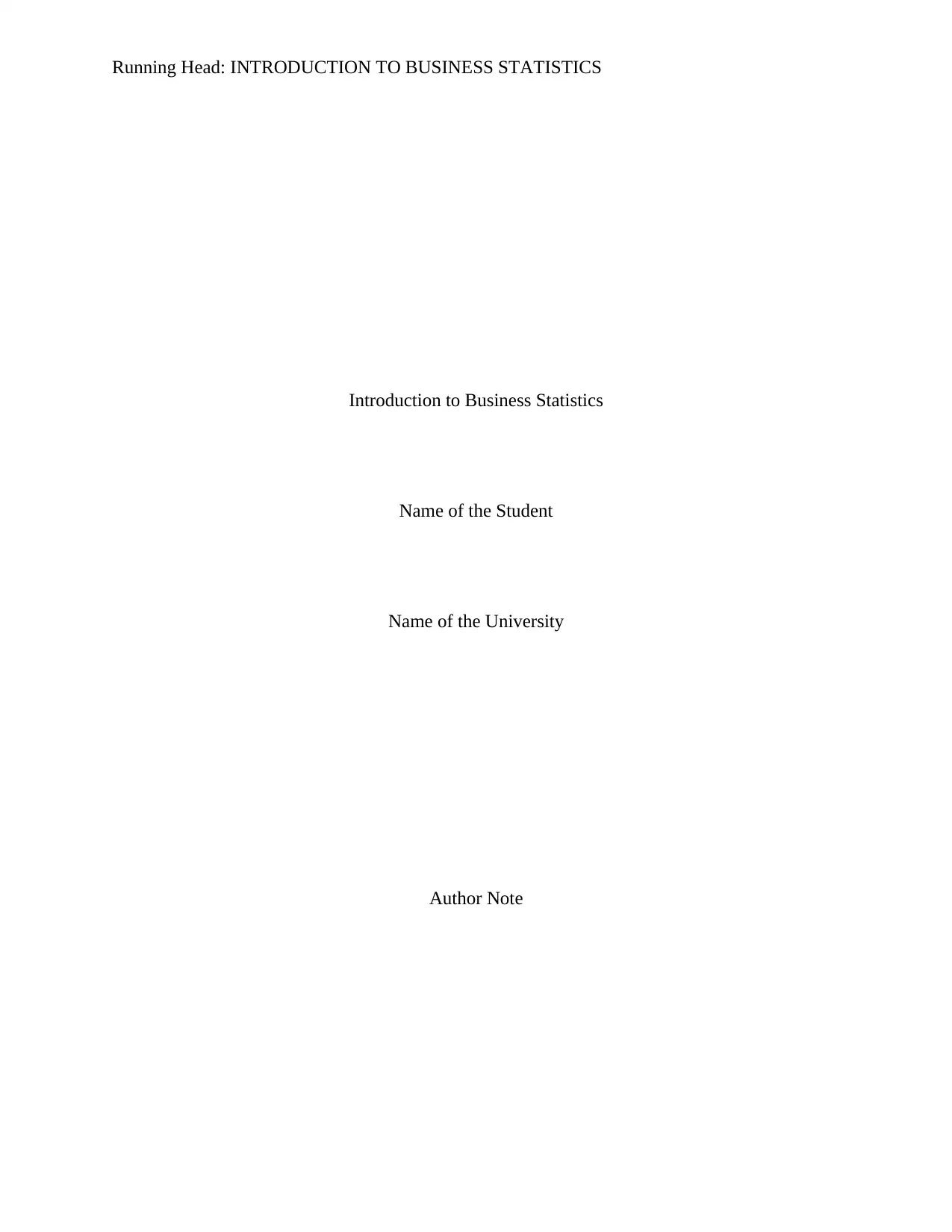
Running Head: INTRODUCTION TO BUSINESS STATISTICS
Introduction to Business Statistics
Name of the Student
Name of the University
Author Note
Introduction to Business Statistics
Name of the Student
Name of the University
Author Note
Paraphrase This Document
Need a fresh take? Get an instant paraphrase of this document with our AI Paraphraser
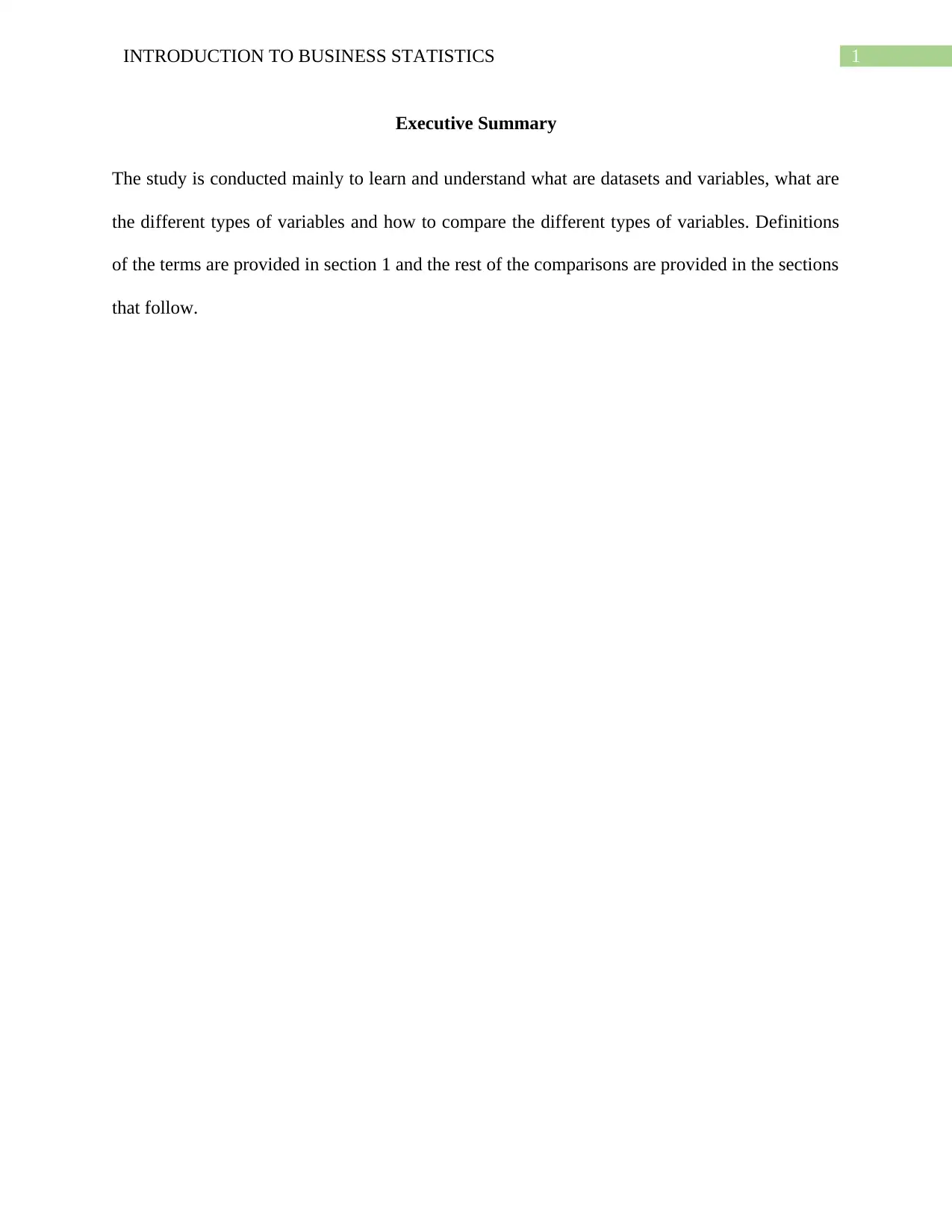
1INTRODUCTION TO BUSINESS STATISTICS
Executive Summary
The study is conducted mainly to learn and understand what are datasets and variables, what are
the different types of variables and how to compare the different types of variables. Definitions
of the terms are provided in section 1 and the rest of the comparisons are provided in the sections
that follow.
Executive Summary
The study is conducted mainly to learn and understand what are datasets and variables, what are
the different types of variables and how to compare the different types of variables. Definitions
of the terms are provided in section 1 and the rest of the comparisons are provided in the sections
that follow.
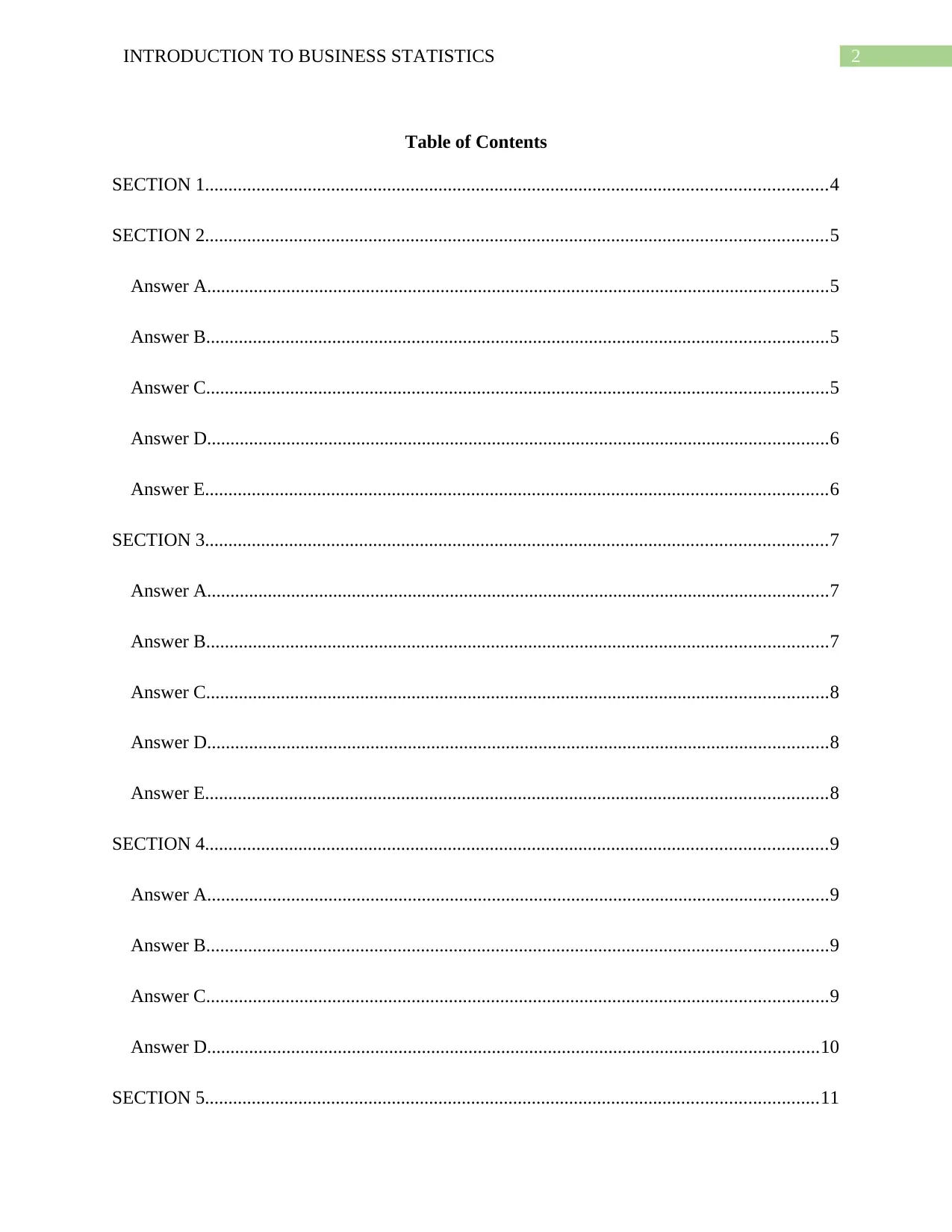
2INTRODUCTION TO BUSINESS STATISTICS
Table of Contents
SECTION 1.....................................................................................................................................4
SECTION 2.....................................................................................................................................5
Answer A.....................................................................................................................................5
Answer B.....................................................................................................................................5
Answer C.....................................................................................................................................5
Answer D.....................................................................................................................................6
Answer E.....................................................................................................................................6
SECTION 3.....................................................................................................................................7
Answer A.....................................................................................................................................7
Answer B.....................................................................................................................................7
Answer C.....................................................................................................................................8
Answer D.....................................................................................................................................8
Answer E.....................................................................................................................................8
SECTION 4.....................................................................................................................................9
Answer A.....................................................................................................................................9
Answer B.....................................................................................................................................9
Answer C.....................................................................................................................................9
Answer D...................................................................................................................................10
SECTION 5...................................................................................................................................11
Table of Contents
SECTION 1.....................................................................................................................................4
SECTION 2.....................................................................................................................................5
Answer A.....................................................................................................................................5
Answer B.....................................................................................................................................5
Answer C.....................................................................................................................................5
Answer D.....................................................................................................................................6
Answer E.....................................................................................................................................6
SECTION 3.....................................................................................................................................7
Answer A.....................................................................................................................................7
Answer B.....................................................................................................................................7
Answer C.....................................................................................................................................8
Answer D.....................................................................................................................................8
Answer E.....................................................................................................................................8
SECTION 4.....................................................................................................................................9
Answer A.....................................................................................................................................9
Answer B.....................................................................................................................................9
Answer C.....................................................................................................................................9
Answer D...................................................................................................................................10
SECTION 5...................................................................................................................................11
⊘ This is a preview!⊘
Do you want full access?
Subscribe today to unlock all pages.

Trusted by 1+ million students worldwide
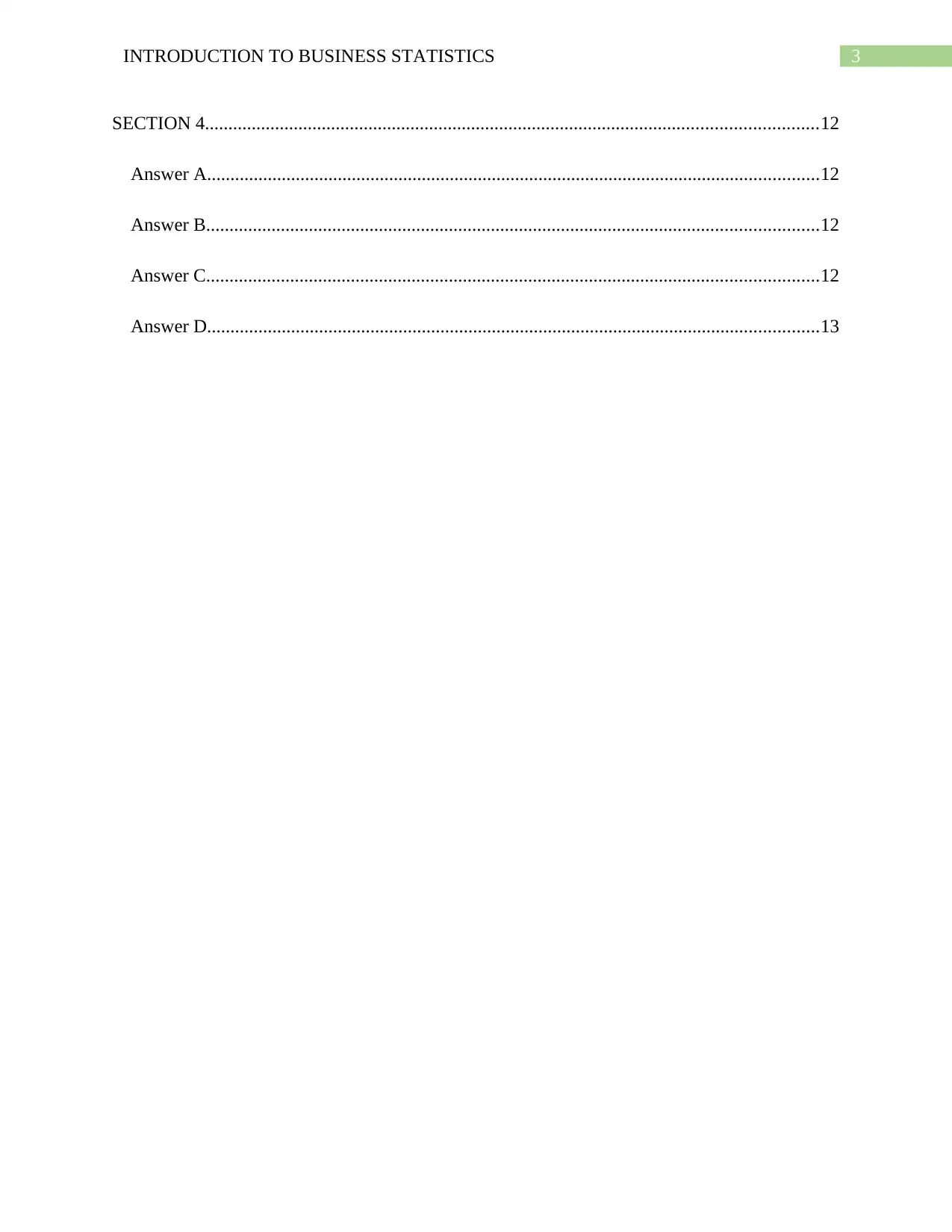
3INTRODUCTION TO BUSINESS STATISTICS
SECTION 4...................................................................................................................................12
Answer A...................................................................................................................................12
Answer B...................................................................................................................................12
Answer C...................................................................................................................................12
Answer D...................................................................................................................................13
SECTION 4...................................................................................................................................12
Answer A...................................................................................................................................12
Answer B...................................................................................................................................12
Answer C...................................................................................................................................12
Answer D...................................................................................................................................13
Paraphrase This Document
Need a fresh take? Get an instant paraphrase of this document with our AI Paraphraser
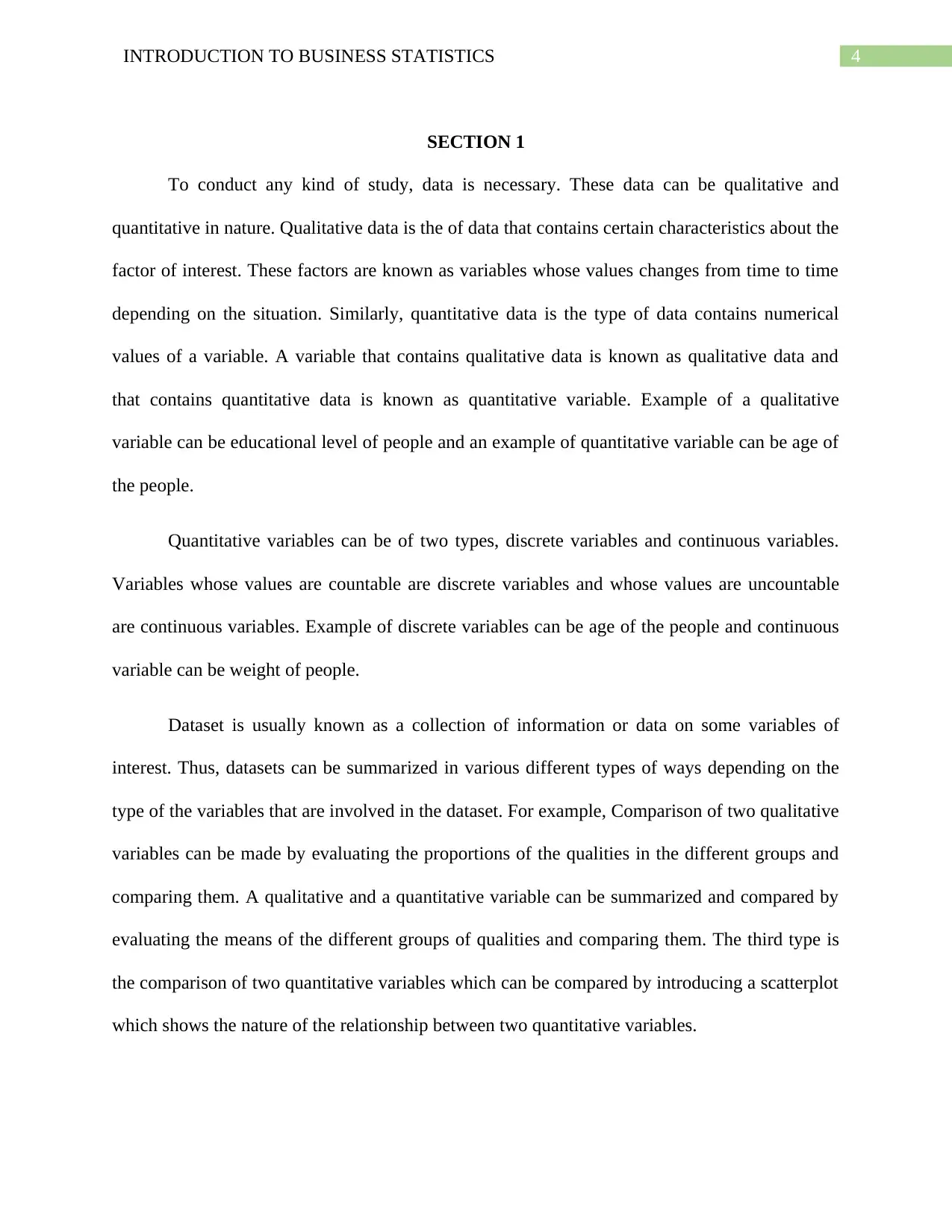
4INTRODUCTION TO BUSINESS STATISTICS
SECTION 1
To conduct any kind of study, data is necessary. These data can be qualitative and
quantitative in nature. Qualitative data is the of data that contains certain characteristics about the
factor of interest. These factors are known as variables whose values changes from time to time
depending on the situation. Similarly, quantitative data is the type of data contains numerical
values of a variable. A variable that contains qualitative data is known as qualitative data and
that contains quantitative data is known as quantitative variable. Example of a qualitative
variable can be educational level of people and an example of quantitative variable can be age of
the people.
Quantitative variables can be of two types, discrete variables and continuous variables.
Variables whose values are countable are discrete variables and whose values are uncountable
are continuous variables. Example of discrete variables can be age of the people and continuous
variable can be weight of people.
Dataset is usually known as a collection of information or data on some variables of
interest. Thus, datasets can be summarized in various different types of ways depending on the
type of the variables that are involved in the dataset. For example, Comparison of two qualitative
variables can be made by evaluating the proportions of the qualities in the different groups and
comparing them. A qualitative and a quantitative variable can be summarized and compared by
evaluating the means of the different groups of qualities and comparing them. The third type is
the comparison of two quantitative variables which can be compared by introducing a scatterplot
which shows the nature of the relationship between two quantitative variables.
SECTION 1
To conduct any kind of study, data is necessary. These data can be qualitative and
quantitative in nature. Qualitative data is the of data that contains certain characteristics about the
factor of interest. These factors are known as variables whose values changes from time to time
depending on the situation. Similarly, quantitative data is the type of data contains numerical
values of a variable. A variable that contains qualitative data is known as qualitative data and
that contains quantitative data is known as quantitative variable. Example of a qualitative
variable can be educational level of people and an example of quantitative variable can be age of
the people.
Quantitative variables can be of two types, discrete variables and continuous variables.
Variables whose values are countable are discrete variables and whose values are uncountable
are continuous variables. Example of discrete variables can be age of the people and continuous
variable can be weight of people.
Dataset is usually known as a collection of information or data on some variables of
interest. Thus, datasets can be summarized in various different types of ways depending on the
type of the variables that are involved in the dataset. For example, Comparison of two qualitative
variables can be made by evaluating the proportions of the qualities in the different groups and
comparing them. A qualitative and a quantitative variable can be summarized and compared by
evaluating the means of the different groups of qualities and comparing them. The third type is
the comparison of two quantitative variables which can be compared by introducing a scatterplot
which shows the nature of the relationship between two quantitative variables.
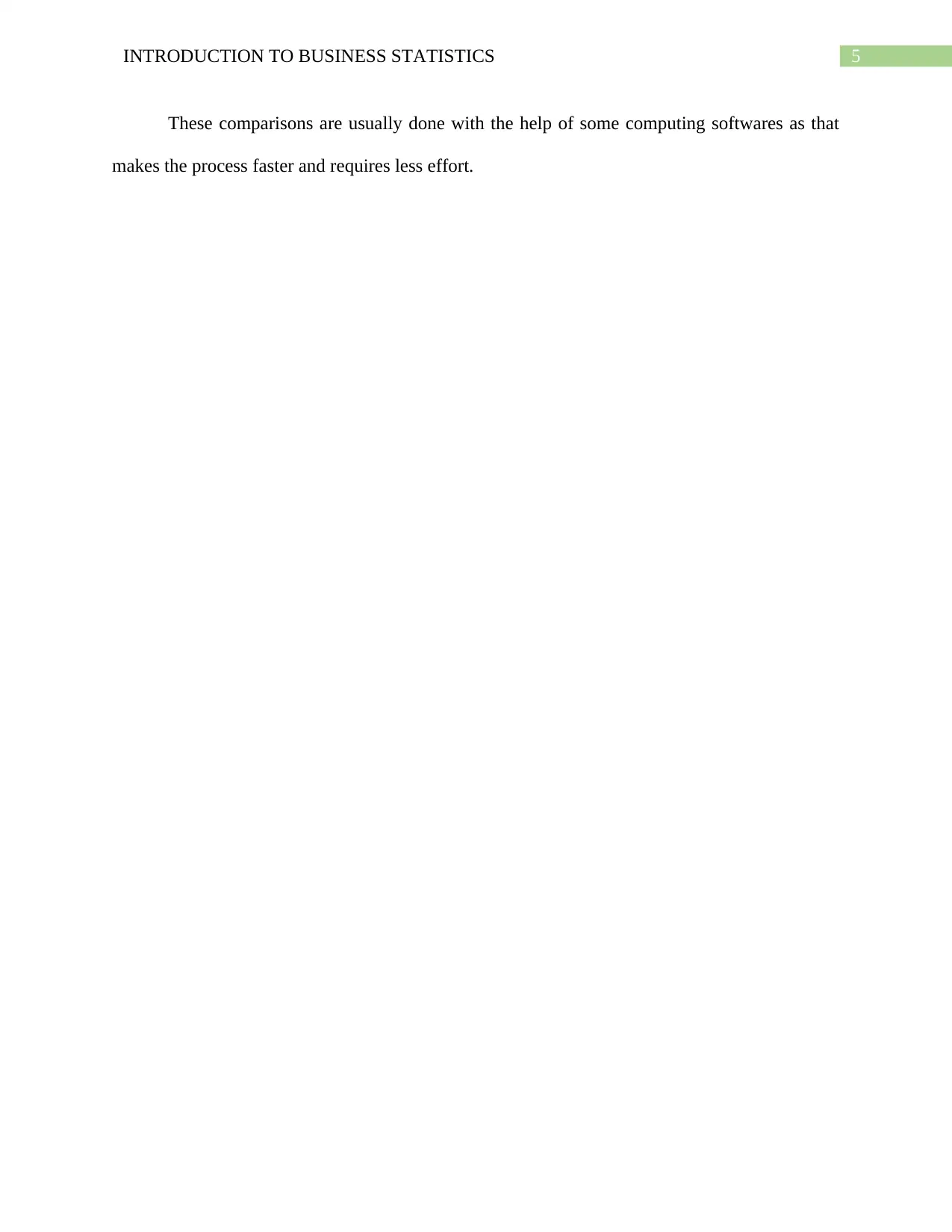
5INTRODUCTION TO BUSINESS STATISTICS
These comparisons are usually done with the help of some computing softwares as that
makes the process faster and requires less effort.
These comparisons are usually done with the help of some computing softwares as that
makes the process faster and requires less effort.
⊘ This is a preview!⊘
Do you want full access?
Subscribe today to unlock all pages.

Trusted by 1+ million students worldwide
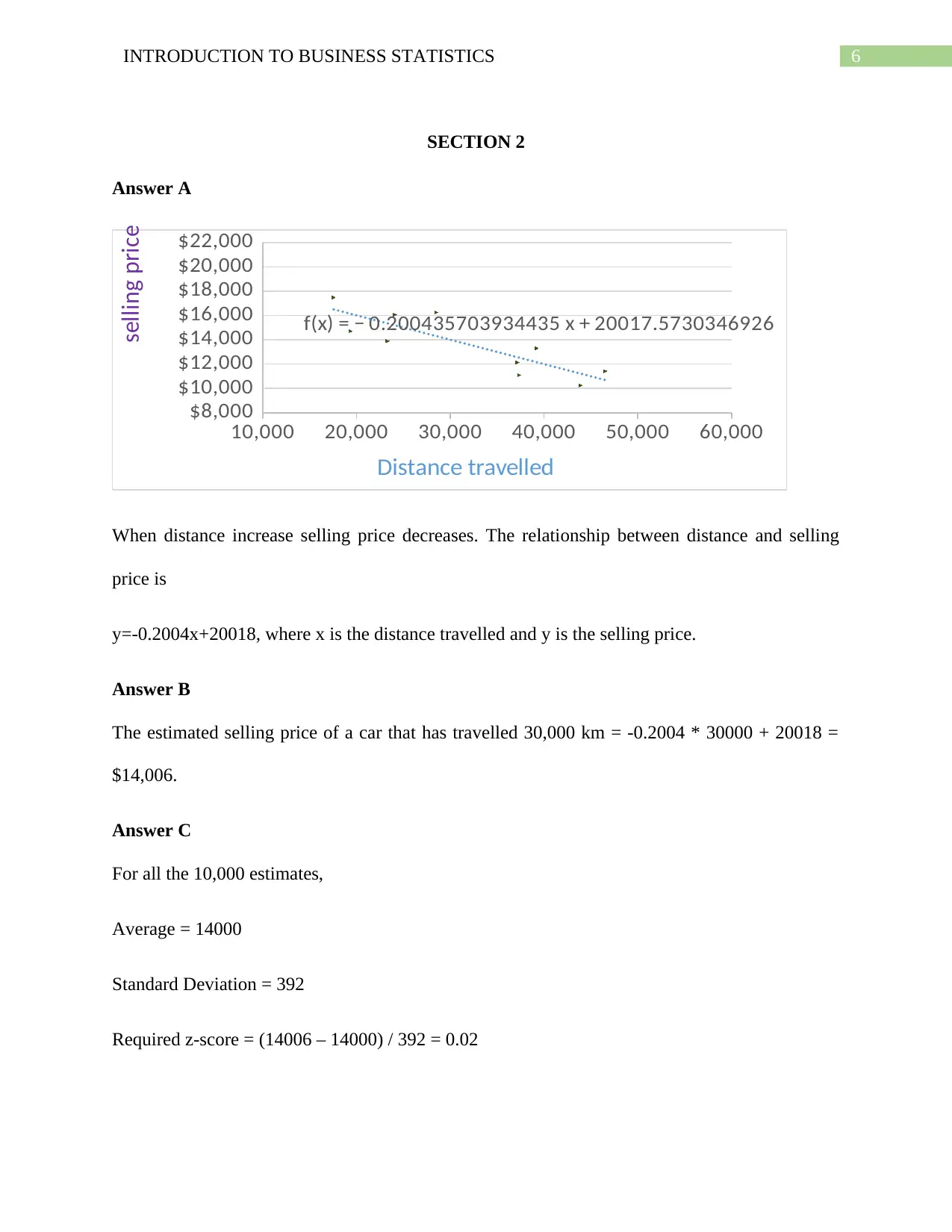
6INTRODUCTION TO BUSINESS STATISTICS
SECTION 2
Answer A
10,000 20,000 30,000 40,000 50,000 60,000
$8,000
$10,000
$12,000
$14,000
$16,000
$18,000
$20,000
$22,000
f(x) = − 0.200435703934435 x + 20017.5730346926
Distance travelled
selling price
When distance increase selling price decreases. The relationship between distance and selling
price is
y=-0.2004x+20018, where x is the distance travelled and y is the selling price.
Answer B
The estimated selling price of a car that has travelled 30,000 km = -0.2004 * 30000 + 20018 =
$14,006.
Answer C
For all the 10,000 estimates,
Average = 14000
Standard Deviation = 392
Required z-score = (14006 – 14000) / 392 = 0.02
SECTION 2
Answer A
10,000 20,000 30,000 40,000 50,000 60,000
$8,000
$10,000
$12,000
$14,000
$16,000
$18,000
$20,000
$22,000
f(x) = − 0.200435703934435 x + 20017.5730346926
Distance travelled
selling price
When distance increase selling price decreases. The relationship between distance and selling
price is
y=-0.2004x+20018, where x is the distance travelled and y is the selling price.
Answer B
The estimated selling price of a car that has travelled 30,000 km = -0.2004 * 30000 + 20018 =
$14,006.
Answer C
For all the 10,000 estimates,
Average = 14000
Standard Deviation = 392
Required z-score = (14006 – 14000) / 392 = 0.02
Paraphrase This Document
Need a fresh take? Get an instant paraphrase of this document with our AI Paraphraser
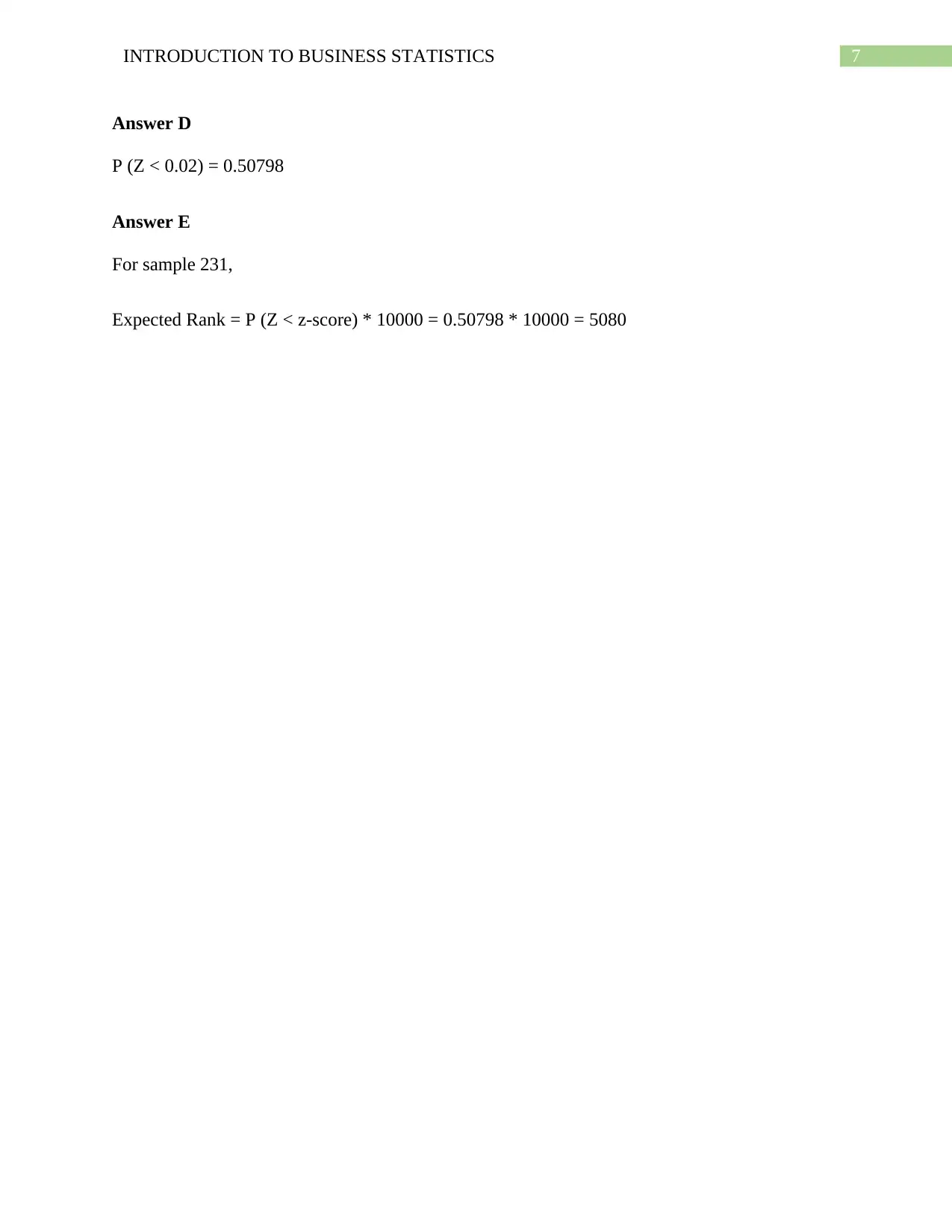
7INTRODUCTION TO BUSINESS STATISTICS
Answer D
P (Z < 0.02) = 0.50798
Answer E
For sample 231,
Expected Rank = P (Z < z-score) * 10000 = 0.50798 * 10000 = 5080
Answer D
P (Z < 0.02) = 0.50798
Answer E
For sample 231,
Expected Rank = P (Z < z-score) * 10000 = 0.50798 * 10000 = 5080
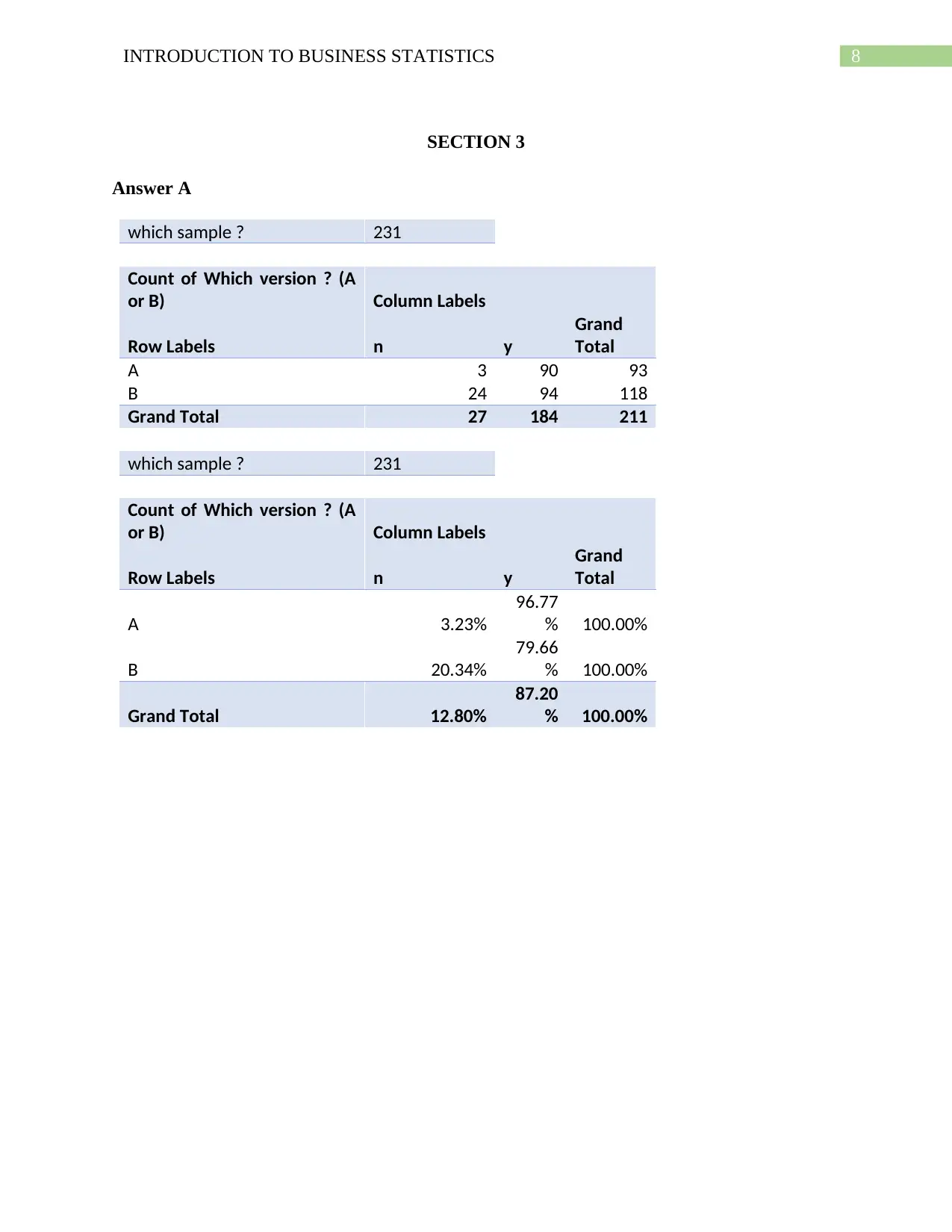
8INTRODUCTION TO BUSINESS STATISTICS
SECTION 3
Answer A
which sample ? 231
Count of Which version ? (A
or B) Column Labels
Row Labels n y
Grand
Total
A 3 90 93
B 24 94 118
Grand Total 27 184 211
which sample ? 231
Count of Which version ? (A
or B) Column Labels
Row Labels n y
Grand
Total
A 3.23%
96.77
% 100.00%
B 20.34%
79.66
% 100.00%
Grand Total 12.80%
87.20
% 100.00%
SECTION 3
Answer A
which sample ? 231
Count of Which version ? (A
or B) Column Labels
Row Labels n y
Grand
Total
A 3 90 93
B 24 94 118
Grand Total 27 184 211
which sample ? 231
Count of Which version ? (A
or B) Column Labels
Row Labels n y
Grand
Total
A 3.23%
96.77
% 100.00%
B 20.34%
79.66
% 100.00%
Grand Total 12.80%
87.20
% 100.00%
⊘ This is a preview!⊘
Do you want full access?
Subscribe today to unlock all pages.

Trusted by 1+ million students worldwide
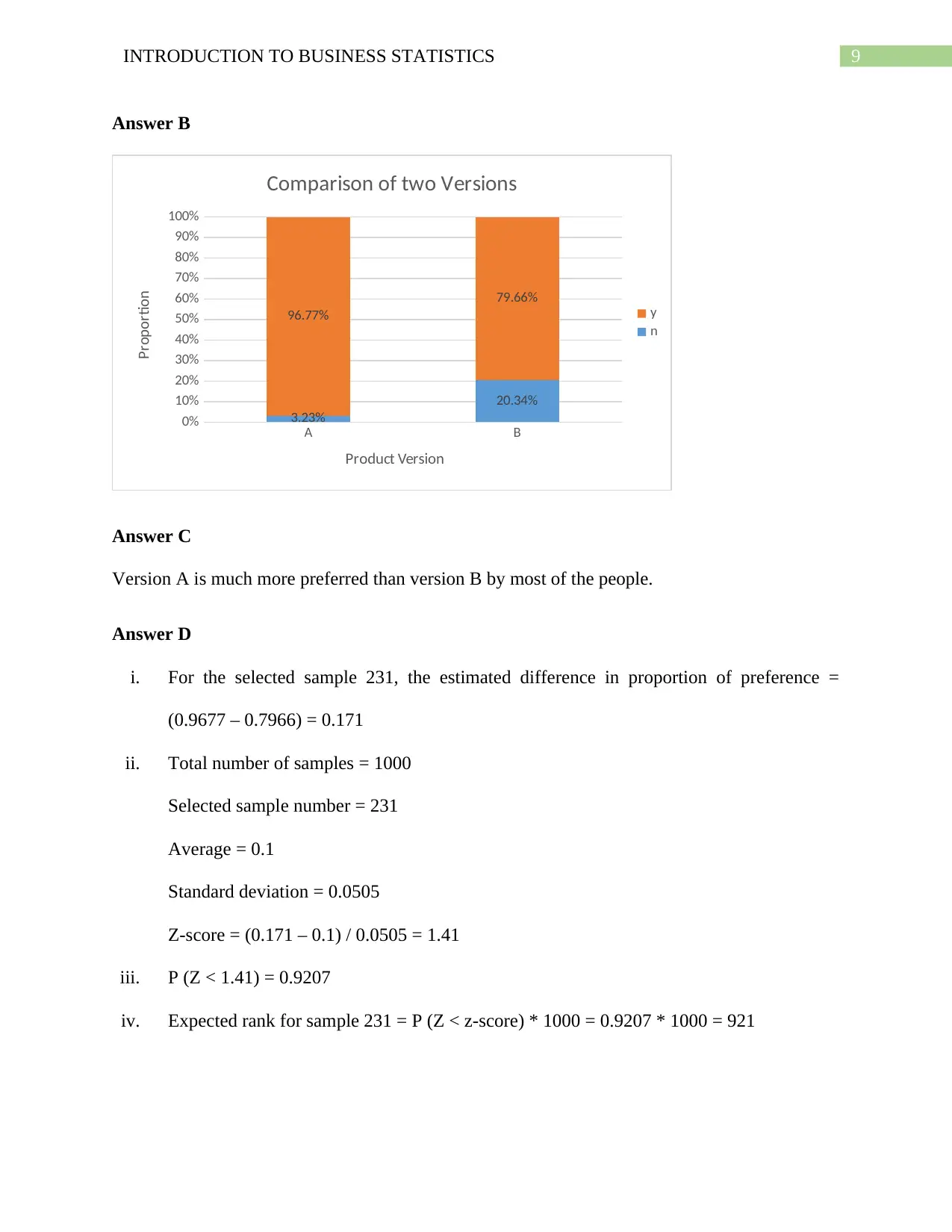
9INTRODUCTION TO BUSINESS STATISTICS
Answer B
A B
0%
10%
20%
30%
40%
50%
60%
70%
80%
90%
100%
3.23%
20.34%
96.77%
79.66%
Comparison of two Versions
y
n
Product Version
Proportion
Answer C
Version A is much more preferred than version B by most of the people.
Answer D
i. For the selected sample 231, the estimated difference in proportion of preference =
(0.9677 – 0.7966) = 0.171
ii. Total number of samples = 1000
Selected sample number = 231
Average = 0.1
Standard deviation = 0.0505
Z-score = (0.171 – 0.1) / 0.0505 = 1.41
iii. P (Z < 1.41) = 0.9207
iv. Expected rank for sample 231 = P (Z < z-score) * 1000 = 0.9207 * 1000 = 921
Answer B
A B
0%
10%
20%
30%
40%
50%
60%
70%
80%
90%
100%
3.23%
20.34%
96.77%
79.66%
Comparison of two Versions
y
n
Product Version
Proportion
Answer C
Version A is much more preferred than version B by most of the people.
Answer D
i. For the selected sample 231, the estimated difference in proportion of preference =
(0.9677 – 0.7966) = 0.171
ii. Total number of samples = 1000
Selected sample number = 231
Average = 0.1
Standard deviation = 0.0505
Z-score = (0.171 – 0.1) / 0.0505 = 1.41
iii. P (Z < 1.41) = 0.9207
iv. Expected rank for sample 231 = P (Z < z-score) * 1000 = 0.9207 * 1000 = 921
Paraphrase This Document
Need a fresh take? Get an instant paraphrase of this document with our AI Paraphraser
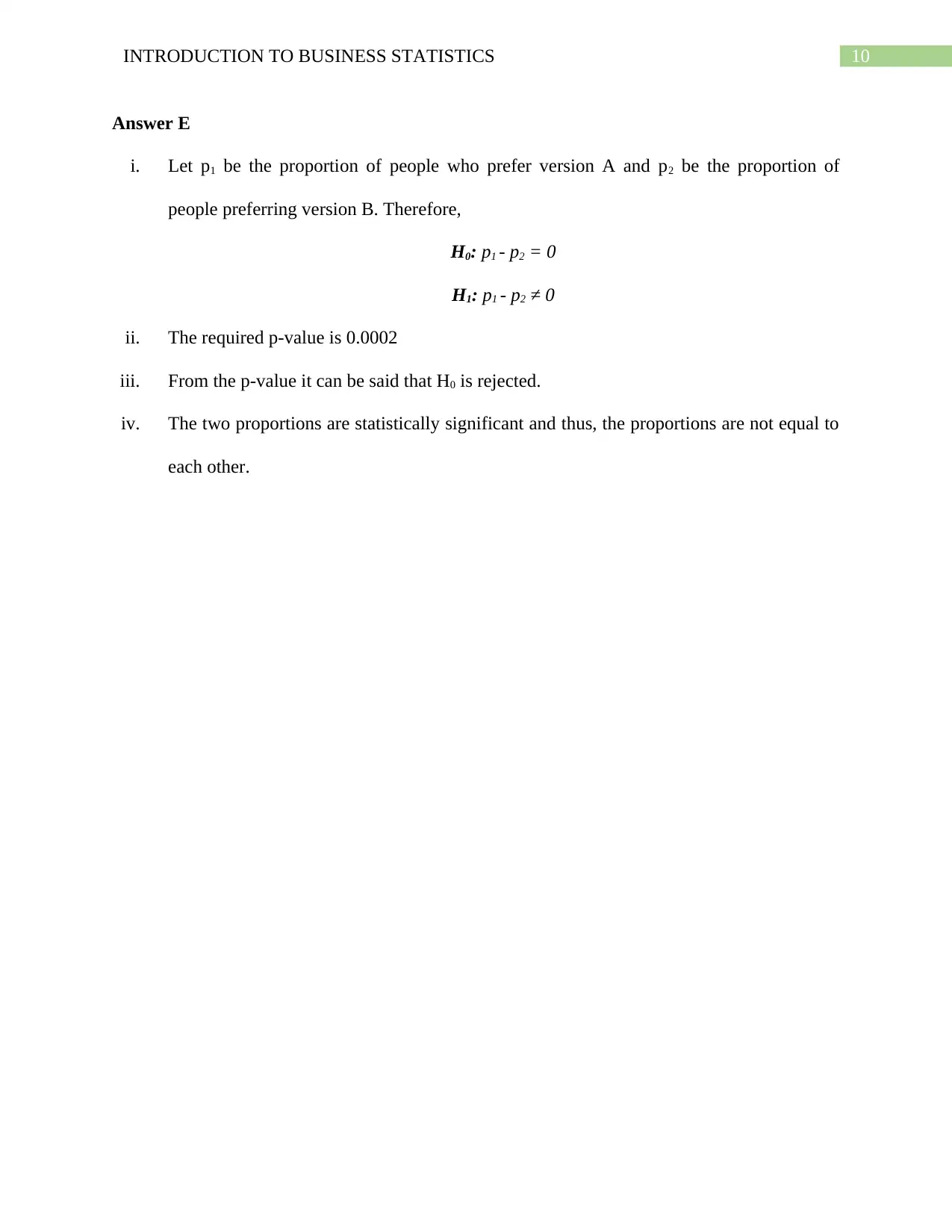
10INTRODUCTION TO BUSINESS STATISTICS
Answer E
i. Let p1 be the proportion of people who prefer version A and p2 be the proportion of
people preferring version B. Therefore,
H0: p1 - p2 = 0
H1: p1 - p2 ≠ 0
ii. The required p-value is 0.0002
iii. From the p-value it can be said that H0 is rejected.
iv. The two proportions are statistically significant and thus, the proportions are not equal to
each other.
Answer E
i. Let p1 be the proportion of people who prefer version A and p2 be the proportion of
people preferring version B. Therefore,
H0: p1 - p2 = 0
H1: p1 - p2 ≠ 0
ii. The required p-value is 0.0002
iii. From the p-value it can be said that H0 is rejected.
iv. The two proportions are statistically significant and thus, the proportions are not equal to
each other.
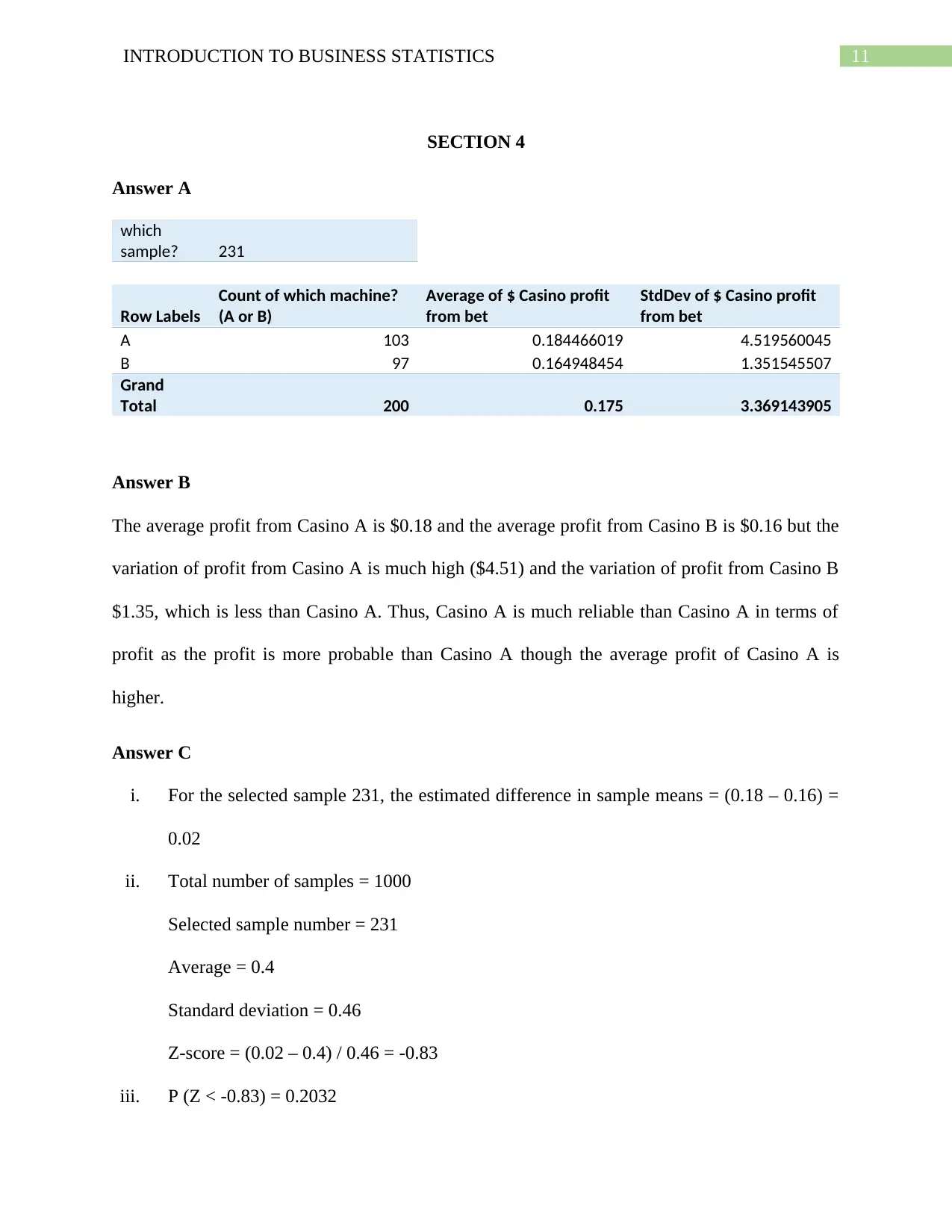
11INTRODUCTION TO BUSINESS STATISTICS
SECTION 4
Answer A
which
sample? 231
Row Labels
Count of which machine?
(A or B)
Average of $ Casino profit
from bet
StdDev of $ Casino profit
from bet
A 103 0.184466019 4.519560045
B 97 0.164948454 1.351545507
Grand
Total 200 0.175 3.369143905
Answer B
The average profit from Casino A is $0.18 and the average profit from Casino B is $0.16 but the
variation of profit from Casino A is much high ($4.51) and the variation of profit from Casino B
$1.35, which is less than Casino A. Thus, Casino A is much reliable than Casino A in terms of
profit as the profit is more probable than Casino A though the average profit of Casino A is
higher.
Answer C
i. For the selected sample 231, the estimated difference in sample means = (0.18 – 0.16) =
0.02
ii. Total number of samples = 1000
Selected sample number = 231
Average = 0.4
Standard deviation = 0.46
Z-score = (0.02 – 0.4) / 0.46 = -0.83
iii. P (Z < -0.83) = 0.2032
SECTION 4
Answer A
which
sample? 231
Row Labels
Count of which machine?
(A or B)
Average of $ Casino profit
from bet
StdDev of $ Casino profit
from bet
A 103 0.184466019 4.519560045
B 97 0.164948454 1.351545507
Grand
Total 200 0.175 3.369143905
Answer B
The average profit from Casino A is $0.18 and the average profit from Casino B is $0.16 but the
variation of profit from Casino A is much high ($4.51) and the variation of profit from Casino B
$1.35, which is less than Casino A. Thus, Casino A is much reliable than Casino A in terms of
profit as the profit is more probable than Casino A though the average profit of Casino A is
higher.
Answer C
i. For the selected sample 231, the estimated difference in sample means = (0.18 – 0.16) =
0.02
ii. Total number of samples = 1000
Selected sample number = 231
Average = 0.4
Standard deviation = 0.46
Z-score = (0.02 – 0.4) / 0.46 = -0.83
iii. P (Z < -0.83) = 0.2032
⊘ This is a preview!⊘
Do you want full access?
Subscribe today to unlock all pages.

Trusted by 1+ million students worldwide
1 out of 16
Related Documents
Your All-in-One AI-Powered Toolkit for Academic Success.
+13062052269
info@desklib.com
Available 24*7 on WhatsApp / Email
![[object Object]](/_next/static/media/star-bottom.7253800d.svg)
Unlock your academic potential
Copyright © 2020–2025 A2Z Services. All Rights Reserved. Developed and managed by ZUCOL.





